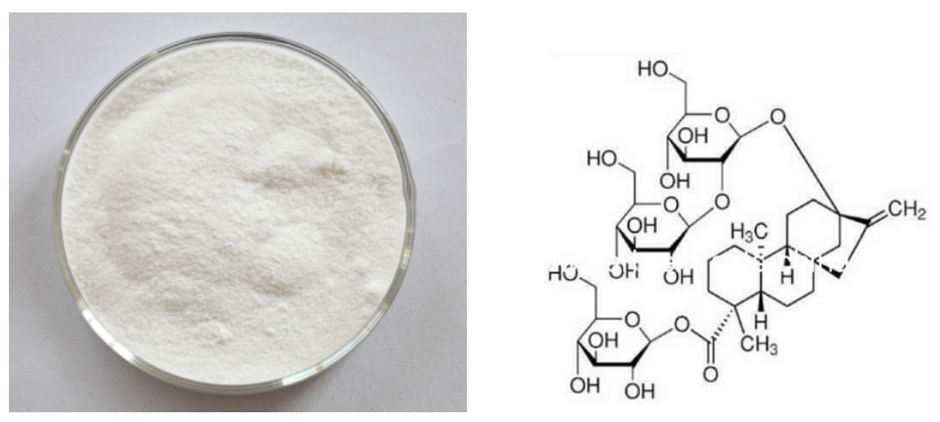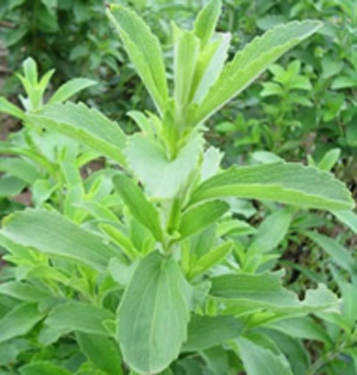Low MOQ for Stevia Extract Factory in Lisbon
Low MOQ for Stevia Extract Factory in Lisbon Detail:
[Latin Name] Stevia rebaudiana
[Plant Source]from China
[Specifications] 1.Stevia Extract Powder (Steviosides)
Total Steviol Glycosides 80%, 90%, 95%
2. Rebaudioside-A
Rebaudioside-A 40%, 60%, 80%, 90%, 95%, 98%
3. Stevioside 90%
One monomer in Steviol Glycosides
[Appearance] Fine white powder
Plant Part Used:Leaf
[Particle size] 80 Mesh
[Loss on drying] ≤5.0%
[Heavy Metal] ≤10PPM
[Shelf life] 24 Months
[Package] Packed in paper-drums and two plastic-bags inside.
[Net weight] 25kgs/drum
Stevia Extract
[Characteristics]
Stevia sugar features high sweetness and low calorie and its sweetness is 200 350 times of that of cane sugar but its calorie is only 1/300 of that of cane sugar.
The component of stevia extract that gives it its sweetness is a mixture of various steviol glycosides. The components of sweetness in stevia leaves are stevioside, rebaudioside A, C, D, E and dulcoside A. Rebaudioside C, D, E and dulcoside A are small in quantity. The principal components are stevioside and rebaudioside A.
The quality of stevioside and rebaudiosideA is better than those of other components, which are commercially extracted and used in various applications.
The steviol glycosides present in stevia extract are referred to as “steviosides” or ¡°stevia extract¡±. Among these “steviosides”, the most common is Stevioside followed by RebaudiosideA. The Stevioside has a slight and pleasant herbal taste and the Rebaudioside-A has no herbal taste.
Although Rebaudioside C and dulcoside A are small in quantity in stevia extract, they are the major components giving bitter aftertaste.
[Function]
A large number of pharmaceutical tests have proved that stevia sugar has no side effects, carcinogens, and is safe for eating.
Compared with cane sugar, it can save 70% of the cost. With pure white color, pleasing taste and no peculiar smell, Stevia sugar is a new sugar source with broad perspective for development. Stevia rebaudianum sugar is the natural low hotsweet agent mostly similar to the flavor of cane sugar, approved to be used by State Ministry of Health and Ministry of Light Industry.
It is the third natural succedaneum of cane sugar and beet sugar with development and health care value, extracted from the leaves of the herbal vegetable of the composite family-stevia rebaudianum.
Product detail pictures:

Related Product Guide:
The organization upholds the philosophy of "Be No.1 in good quality, be rooted on credit history and trustworthiness for growth", will keep on to provide previous and new customers from home and overseas whole-heatedly for Low MOQ for Stevia Extract Factory in Lisbon , The product will supply to all over the world, such as: Ecuador, Greece, Poland, Nowadays our products sell all over the domestic and abroad thanks for the regular and new customers support. We provide high quality product and competitive price, welcome the regular and new customers cooperate with us!
Soybean Cookies
Make a environmentally friendly vegetable into a fantastic crisp Drop motivated cookie!
Sign up for Jolene Sugarbaker inside The Trailer Park Exam Kitchen area as she whips up tasty spending budget treats!
Currently, Jolene takes the Soybean which is also identified as Edamame : and turns it into a Shock Soybean Cookie with the tastes of Cinnamon and Nutmeg!
Your friends will under no circumstances guess that they are having a serving of veggies when making the most of this delightful cookie!
Shock your friends with the solution just after they flavor them!
Soybeans are wealthy in nutritional fiber, that is ideal for some of you that pop the supplements and acquire the fiber shakes.
When Jolene cannot promise this Cookie is unquestionably nutritious, she can promise that this is a suprising sweet crisp raisin cookie that will delight your whole loved ones!
Try them these days, and if you do, send pics! at JoleneSugarbaker AT Gmail.com
They will be more Trailer Park Cooking Displays Quickly!
So be confident to subscribe!
Leave a Remark so I know you stopped by! Love You!
Insert Jolene on Fb at :
https://www.Fb.com/JoleneSugarbaker
Insert Jolene on Google +
Obtain out which Politician Jolene’s mad at, and appreciate Random Cat Images!
Stick to the Trailer Park On Twitter :
https://www.Twitter.com/JolenesTrailer
Pay a visit to the Trailer Park Shop for unique gifts created by Jolene Sugarbaker
https://www.TrailerParkStore.com
Soybean Cookies
three Tablespoons Butter
1/two Cup Sugar
1 Cup Cooked Soybeans, Chopped or Ground
two Eggs
1 TSP Ground Nutmeg
1 TSP Ground Cinnamon
1 1/two Cups All-Objective Flour
1/two Cup Milk
1/two Cup Raisins
1 1/two TSP Vanilla Extract
Cream Butter and Sugar in Significant Bowl
Insert Soybeans and Eggs, Blend
Insert Nutmeg and Cinnamon, Blend
Insert Flour and Milk Alternately
Stir in Raisins and Vanilla, Blend
Fall by 50 percent Teaspoon on greased baking sheet and make confident they flatten, bake in a preheated oven at 375 10-12 minutes! You should not Burn up!
What does Gregg Valentino do to these poor innocent pigs in this episode of Storytime? You know it won’t end well unfortunately…
Check out this insane story involving pigs, a raccoon, quads, and a very shocking ending.
Bodybuilding, weight training, fitness – all on the Generation Iron Fitness Network.
Try our GYMOJI bodybuilding emojis on the app store: https://appsto.re/us/oyBLdb.i
Be sure to subscribe to receive updates from the GI Fitness Network:
https://www.youtube.com/subscription_center?add_user=GenerationIron
Check out our official website:
https://www.generationiron.com/
Check out our Facebook:
https://www.facebook.com/GenerationIron
And follow us on Twitter:
https://twitter.com/GI_Fitness
The factory has advanced equipment, experienced staffs and good management level, so product quality had assurance, this cooperation is very relaxed and happy!






